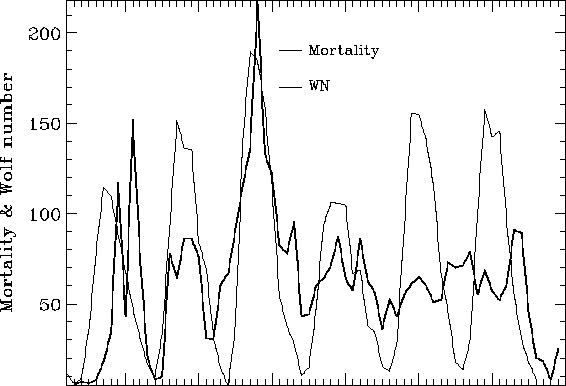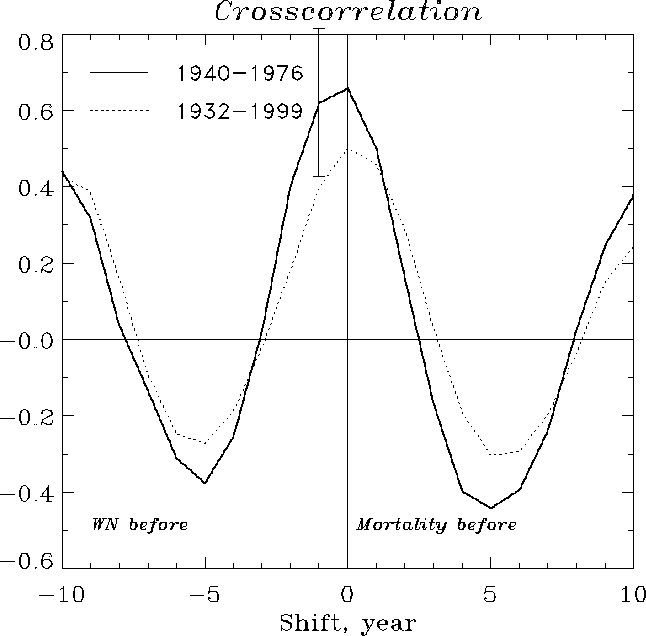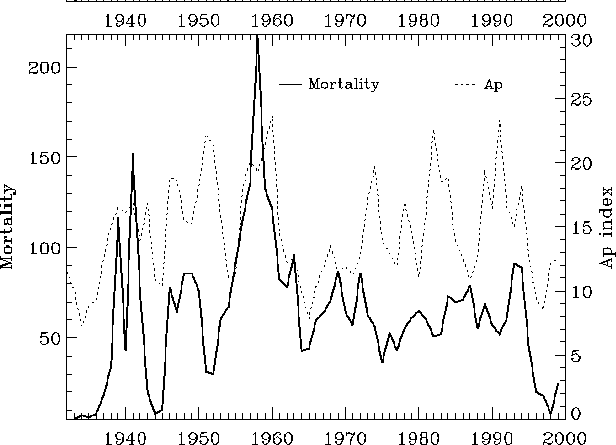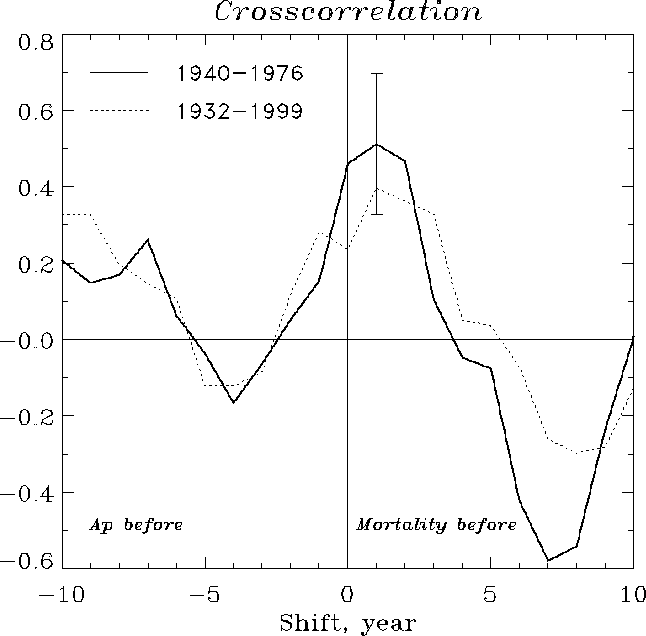Difference between revisions of "Stress biologique"
(→REFERENCES) |
(→Ap Index & Wolf Number correlation risk) |
||
| Ligne 2: | Ligne 2: | ||
===Mortalité et Nombre de Wolf=== | ===Mortalité et Nombre de Wolf=== | ||
| + | |||
| + | * Ecosystème : | ||
| + | * Zone géographique : | ||
| + | * Durée : | ||
[[image:stress-WN.gif]] | [[image:stress-WN.gif]] | ||
[[image:stress-WN-correlation.gif]] | [[image:stress-WN-correlation.gif]] | ||
| + | k = 0.74± 0.21 | ||
===Mortalité et Ap Index === | ===Mortalité et Ap Index === | ||
| Ligne 10: | Ligne 15: | ||
[[image:stress-AP-correlation.gif]] | [[image:stress-AP-correlation.gif]] | ||
| + | [...] Ces considérations nous indiquent que les fluctuations de températures et les autres facteurs météorologiques ne peuvent expliquer ces pics de mortalité. | ||
| + | La comparaison des données sur la mortalité avec les Nombres de Wolf (WN), voir panneau du haut, fig.1 montre un degré élevé de corrélation (k = 0.74± 0.21) et pour l'[[héliosphère#Ap index|index Ap]]" présenté dans le panneau du bas. "L'index AP" est un index du champ magnétique planétaire et donne le niveau de perturbation magnétique entre les latitudes géomagnétiques 46° et 63° nord / sud. | ||
| + | |||
| + | Dans tous les cas, la dépendance de la réponse biologique des plantes lié à leur état physiologique a été démontré en relation avec les [[Champs ElectroMagnétiques Faibles (CEMF)]] [Kashulin, Pershakov, 1995]. | ||
| + | |||
| + | Nous suggérons qu'un facteur héliogéophysique non identifié est impliqué dans le processus de modulation de la mortalité, et sa variation est mieux corrélée à celle du Nombre de Wolf qu'à la perturbation magnétique ([[héliosphère#Ap index|index Ap]]). | ||
| − | The special consideration shows that temperature fluctuations and other meteorological factors can not explain the mortality peaks | + | <i>The special consideration shows that temperature fluctuations and other meteorological factors can not explain the mortality peaks. |
The comparison of the mortality data with Wolf numbers (WN), see top panel of Fig.1, has showed a rather high level of correlation (k = 0.74± 0.21) for | The comparison of the mortality data with Wolf numbers (WN), see top panel of Fig.1, has showed a rather high level of correlation (k = 0.74± 0.21) for | ||
| − | Ap index is presented on the bottom panel. It is a planetary magnetic index and shows the magnetic disturbance level between 46° and 63° north and south geomagnetic latitudes | + | [[héliosphère#Ap index|Ap index]] is presented on the bottom panel. It is a planetary magnetic index and shows the magnetic disturbance level between 46° and 63° north and south geomagnetic latitudes |
| − | In any case, the dependence of plant biological response on it physiological state was shown in relation to weak artificial EM fields effects [Kashulin, Pershakov, 1995]. | + | In any case, the dependence of plant biological response on it physiological state was shown in relation to [[weak artificial EM fields effects]] [Kashulin, Pershakov, 1995]. |
| − | We suggest that unidentified intermediate heliogeophysical factor is involved in the modulation of mortality process, and its variation matches making more to WN as compared to the magnetic disturbance index Ap | + | We suggest that unidentified intermediate heliogeophysical factor is involved in the modulation of mortality process, and its variation matches making more to WN as compared to the magnetic disturbance [[héliosphère#Ap index|index Ap]] </i> |
====REFERENCES==== | ====REFERENCES==== | ||
Version du 08:44, 28 octobre 2005
Sommaire
Ap Index & Wolf Number correlation risk
Mortalité et Nombre de Wolf
- Ecosystème :
- Zone géographique :
- Durée :
k = 0.74± 0.21
Mortalité et Ap Index
[...] Ces considérations nous indiquent que les fluctuations de températures et les autres facteurs météorologiques ne peuvent expliquer ces pics de mortalité. La comparaison des données sur la mortalité avec les Nombres de Wolf (WN), voir panneau du haut, fig.1 montre un degré élevé de corrélation (k = 0.74± 0.21) et pour l'index Ap" présenté dans le panneau du bas. "L'index AP" est un index du champ magnétique planétaire et donne le niveau de perturbation magnétique entre les latitudes géomagnétiques 46° et 63° nord / sud.
Dans tous les cas, la dépendance de la réponse biologique des plantes lié à leur état physiologique a été démontré en relation avec les Champs ElectroMagnétiques Faibles (CEMF) [Kashulin, Pershakov, 1995].
Nous suggérons qu'un facteur héliogéophysique non identifié est impliqué dans le processus de modulation de la mortalité, et sa variation est mieux corrélée à celle du Nombre de Wolf qu'à la perturbation magnétique (index Ap).
The special consideration shows that temperature fluctuations and other meteorological factors can not explain the mortality peaks. The comparison of the mortality data with Wolf numbers (WN), see top panel of Fig.1, has showed a rather high level of correlation (k = 0.74± 0.21) for Ap index is presented on the bottom panel. It is a planetary magnetic index and shows the magnetic disturbance level between 46° and 63° north and south geomagnetic latitudes
In any case, the dependence of plant biological response on it physiological state was shown in relation to weak artificial EM fields effects [Kashulin, Pershakov, 1995]. We suggest that unidentified intermediate heliogeophysical factor is involved in the modulation of mortality process, and its variation matches making more to WN as compared to the magnetic disturbance index Ap
REFERENCES
Breus T.K., Komarov F.I., Musin M.M., Naborov I.V., Rapoport S.I. Heliogeophysical factors and teir influence on cyclic processes in biosphere. Itogi Aviakosm Ekolog Med. 1995;29(3):19-21. Mikhail N. Zhadin (zhadin@online.stack.net) (4) EFFECTS OF VOLCANIC ERUPTIONS AND SUNSPOTS ON CLIMATE - UB News Service, 11 June 2002 On the Relationship of the Equatorial Electron Density (foF2) with Solar Soft X-ray Fluxes



